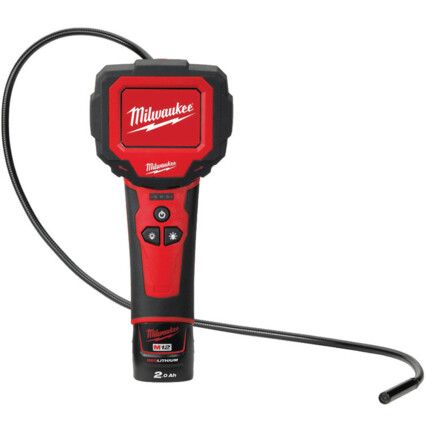Inspection Camera
Discover inspection cameras and accessories at Cromwell online. We carefully select our range for high-quality and reliability from brands like Bosch®.
What are inspection cameras?
The purpose of an inspection camera is as an exploratory device used to access tight or unreachable spaces, such as pipework and wall cavities. They typically feature a handheld digital screen with a very small camera attached to the end of a long probe. Modern variations on the handheld style operate utilising WIFI connection, uploading footage to the cloud for viewing from a range of devices.
Why buy inspection cameras?
Inspection cameras are ideal for locating the source of an issue. For areas tucked away in tight spaces, like a blockage down a drain and a break in a machine engine, an inspection camera prevents unnecessary dismantling and can help to discover a simple fix.
When are inspection cameras used?
A convenient piece of equipment in a range of industries, inspection cameras feature heavily in the automotive and maintenance industries to access pipework, wall cavities and engine components. A variation of the inspection camera called an endoscope is utilised in the health sector for internal procedures such as an endoscopy.
Inspection camera types
• Hand-held inspection camera - Often called a borescope, this is the classic design and features a small screen with a hand grip and control buttons. A small camera at the end of a cable is inserted and fed to the desired area. This type comes in a waterproof variant and is a plumber's best friend.
• Reel inspection camera - As the name suggests, instead of a cable, the camera is fitted onto the end of a long reel. This type doesn't have a viewing screen, instead, the cable can be connected to a device of the operator's choosing using a USB cable. These are available in waterproof and non-waterproof options.
Considerations when choosing an inspection camera
• Type - hand held inspection cameras work well when a limited cable is required, while reel inspection cameras are ideal when dealing with long distances or drops.
• Accessories - some models are available with integrated hooks or magnets, while others are just a basic design with accessories available separately.
Inspection camera jargon buster
Understanding the quality and safety characteristics of a product allows you to make the best purchasing decision for you. So, to keep you informed, we've outlined and explained the applicable standard for inspection cameras...
What does the standard BS EN 60529:1992 + A2:2013 mean?
This standard bears the title Degrees of protection provided by enclosures (IP Code). It defines the Ingress Protection required for electrical equipment against the penetration of debris and fluids, like dirt, dust, and water into the cavity of the enclosure.
Ingress Protection, or IP as it is marked on the product; features two numbers, for example, IP67. The first number denotes the protection against the ingress of solids, such as grit and dirt, while the second number stands for liquids, like water and the protection given against splash, spray, and complete submersion.
IP ratings range between 0, which means no protection is provided and ascends through the number's range up to 6, which denotes full, or the strongest protection is provided.
Let's break it down...
• BS - This standard is monitored by the British Standards Institute.
• EN - IP ratings have been integrated into the European Norm.
• 60529 - This is the identifying legislation number.
• 1992 - Originally published in 1992, this standard has since been amended but is still current.
• A2 - A second amendment was made to this standard to keep it current.
• 2013 - This amendment was made in 2013.
FAQs
What's the best battery for an inspection camera?
Inspection cameras will either use AA batteries or a Li-ion battery. Lithium-ion batteries are rechargeable and so are a more sustainable option. However, with improvements in rechargeable battery technology, investing in a good set of rechargeable AAs is also a good option. You'll get less use time this way, but your choice will depend on how often you use the inspection camera, and a backup Li-ion battery is often a good shout anyway.
What's the operating temperature of an inspection camera?
Operating temperatures will differ from model to model and will depend on the construction material and method of construction. Manufacturers will include the operating temperature range in their technical specifications for inspection before purchase.
